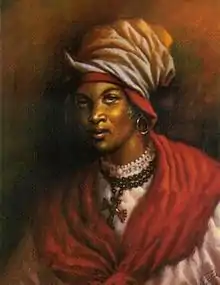Cécile Fatiman
Cécile Fatiman (1771-1883), was a Haitian vodou priestess, a mambo. She is famous for her participation in the vodou ceremony at Bois Caïman, which is considered to be one of the starting points of the Haitian Revolution.
Cécile Fatiman | |
|---|---|
 | |
| Born | 1771 |
| Died | January 1883 |
| Nationality | Haitian |
| Known for | Vodou priestess and figure of the Haitian Revolution |
| Title | Mambo (Vodou High Priestess) |
| Spouse(s) | Jean-Louis Pierrot |
| Children | Marie Louise Amelia Celestina Pierrot Alexis |
| Part of a series on |
| Slavery |
|---|
 |
Early life and origins
Cécile Fatiman was the daughter of an African slave woman and a white Frenchman from Corsica. She and her mother were sold as slaves at Saint Domingue, while her two brothers disappeared in the slave trade.[1] She is described as having long silky hair and green eyes.[1]
Haitian researcher Rodney Salnave (Bwa Kay Il-Ment) has researched Fatiman's origins. His research has indicated that her father was likely a Corsican prince and a grandson of Theodore Von Neuhoff or Theodore of Corsica, sole king of Corsica. He also believes that her last name, Fatiman, may actually have been a middle name, Attiman, which would have been given after Gregorio Attiman, of Leghorn or Livorno, Italy, who was one of Theodore Neuhoff's pages[2][3] during his conquest of the Corsican throne in April 1736. This prompted him to state that her full name was most likely Cécile Attiman Coidavid, as she was the daughter of Célestina Coidavid, and the sister of Marie-Louise Coidavid, Queen of Haiti from 1811 to 1820.[4] She was the mother-in-law of Pierre Nord Alexis.
Slave rebellion
In August 1791, Fatiman presided over a ceremony at the Bois Caïman in the role of mambo together with priest Dutty Boukman. Boukman prophesied that the slaves Jean François, Biassou, and Jeannot would be leaders of a resistance movement and revolt that would free the slaves of Saint-Domingue. An animal was sacrificed, an oath was taken, and Boukman and the priestess exhorted the listeners to take revenge against their French oppressors and "[c]ast aside the image of the God of the oppressors."[5] According to the Encyclopedia of African Religion: "Blood from the animal, and some say from humans as well, was given in a drink to the attendees to seal their fates in loyalty to the cause of liberation of Sainte-Domingue."[6] During the ceremony, Cécile Fatiman acted as if she were possessed by the goddess Erzulie.[7] She was also said to have cut the throat of a pig and offered its blood to the spectators.[7] A week later, 1800 plantations had been destroyed and 1000 slaveholders killed.[8][9]
Later life
Fatiman was married to Louis Michel Pierrot, a general in the Haitian revolutionary army and later president.[1] She is reported to have lived to the age of 112.[1]
References
- Joan Dayan, Haiti, History, and the Gods, University of California Press, 1998
- Gasper, Julia (2013). Theodore Von Neuhoff, King of Corsica: The Man Behind the Legend. Newark: University of Delaware press. p. 96. ISBN 9781611494402.
- "Théodore, le Doge, les Gouverneurs et les Procurateurs de la République de Gênes". Mercure Historique et Politique (June, 1736): 631. 1736. Retrieved 24 February 2017.
- "Célestina Coidavid - Genealogy". Rootsweb.Ancestry.com. Retrieved April 4, 2015.
- Charles Arthur and Michael Dash (eds), Libète: A Haiti Anthology (Princeton, NJ: Markus Wiener Publishers, 1999), 36.
- Molefi Kete Asante and Ama Mazama. Encyclopedia of African Religion, Volume 1, Sage Publications, p. 131.
- Richard M. Juang, Africa and the Americas: Culture, Politics, and History, ABC-CLIO, 2008.
- Diouf, Sylviane Anna; Kamara, Sylviane (1998). Servants of Allah: African Muslims Enslaved in the Americas. New York University Press. p. 152. ISBN 0-8147-1904-X.
- John Mason, "African Religions in The Caribbean: Continuity and Change".